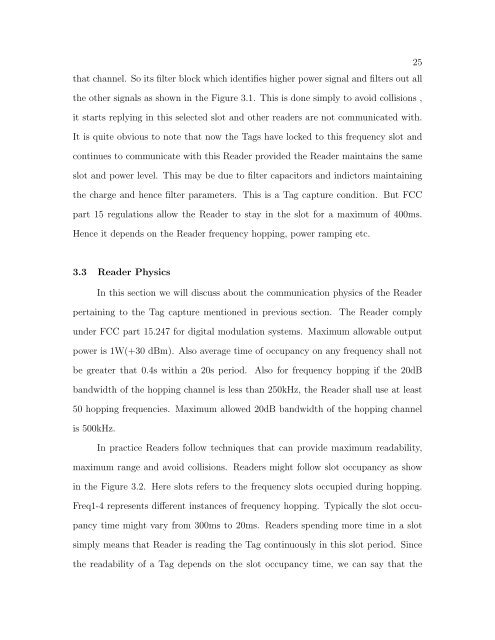BLOCKING READER: DESIGN AND IMPLEMENTATION OF A ...
BLOCKING READER: DESIGN AND IMPLEMENTATION OF A ...
BLOCKING READER: DESIGN AND IMPLEMENTATION OF A ...
Create successful ePaper yourself
Turn your PDF publications into a flip-book with our unique Google optimized e-Paper software.
that channel. So its filter block which identifies higher power signal and filters out all<br />
the other signals as shown in the Figure 3.1. This is done simply to avoid collisions ,<br />
it starts replying in this selected slot and other readers are not communicated with.<br />
It is quite obvious to note that now the Tags have locked to this frequency slot and<br />
continues to communicate with this Reader provided the Reader maintains the same<br />
slot and power level. This may be due to filter capacitors and indictors maintaining<br />
the charge and hence filter parameters. This is a Tag capture condition. But FCC<br />
part 15 regulations allow the Reader to stay in the slot for a maximum of 400ms.<br />
Hence it depends on the Reader frequency hopping, power ramping etc.<br />
3.3 Reader Physics<br />
In this section we will discuss about the communication physics of the Reader<br />
pertaining to the Tag capture mentioned in previous section. The Reader comply<br />
under FCC part 15.247 for digital modulation systems. Maximum allowable output<br />
power is 1W(+30 dBm). Also average time of occupancy on any frequency shall not<br />
be greater that 0.4s within a 20s period. Also for frequency hopping if the 20dB<br />
bandwidth of the hopping channel is less than 250kHz, the Reader shall use at least<br />
50 hopping frequencies. Maximum allowed 20dB bandwidth of the hopping channel<br />
is 500kHz.<br />
In practice Readers follow techniques that can provide maximum readability,<br />
maximum range and avoid collisions. Readers might follow slot occupancy as show<br />
in the Figure 3.2. Here slots refers to the frequency slots occupied during hopping.<br />
Freq1-4 represents different instances of frequency hopping. Typically the slot occu-<br />
pancy time might vary from 300ms to 20ms. Readers spending more time in a slot<br />
simply means that Reader is reading the Tag continuously in this slot period. Since<br />
the readability of a Tag depends on the slot occupancy time, we can say that the<br />
25
















